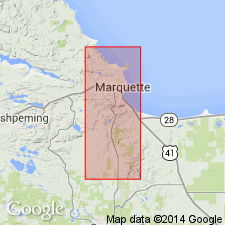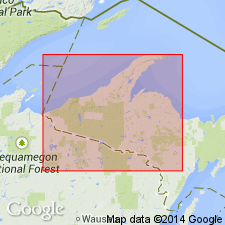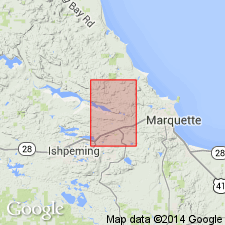
- Usage in publication:
-
- Wewe slate*
- Modifications:
-
- Named
- Dominant lithology:
-
- Slate
- Graywacke
- Conglomerate
- Quartzite
- AAPG geologic province:
-
- Lake Superior region
Summary:
Is Algonkian formation (3rd of 6 ascending) named in Lower Marquette series and mapped (pl XIII) in mostly continuous arcuate belt southwest of Marquette, MI (Lake Superior region). Is named for its "typical development on the Wewe Hills west of Goose Lake"; Wewe Hills shown on map in secs 23 and 24, T47N, R26W, Marquette Co., MI. Overlies Kona dolomite (new); overlain by Ajibik quartzite (new); average thickness may be as much as 500 ft, but estimates are difficult due to complicated folding. Is comprised of conglomerate, quartzite, graywacke, and slate. Basal conglomerate and quartzite content varies locally according to nature of subjacent rock; fragments comprise white sheared granite (locally with large feldspar crystals), pink granite, gneissoid granite, feldspathic pegmatite, chloritic schist or gneiss, sericite-schist or gneiss, quartz, and other rocks. Quartzites grade into graywacke with similar, but finer groundmass; chlorite is abundant, very small fragmental quartz and feldspar grains are present, and secondary iron oxides (hematite and magnetite) are frequent. Graywackes fine and pass into slates, frequently developing slaty cleavage or schistose structure, and usually with variable amounts of iron oxides (limonite, hematite, and magnetite). Slate and graywacke is locally conglomeratic. Novaculite also occurs.
Source: GNU records (USGS DDS-6; Reston GNULEX).

- Usage in publication:
-
- Wewe Slate*
- Modifications:
-
- Age modified
- AAPG geologic province:
-
- Lake Superior region
- Wisconsin arch
Summary:
Pg. 45-46. Wewe Slate. Placed in the Chocolay Group of the Animikie series. Poorly exposed in the Marquette and Sands 7.5-min quadrangles, Marquette County, northwestern Michigan (Lake Superior region). Is mostly either gray and thick-bedded (nonlaminated) or green and white and thinly laminated slate. Thickness approximately 650 feet. Conformably overlies Kona Dolomite of Chocolay Group; underlies Ajibik Quartzite of Menominee Group with disconformity or slight angular unconformity. Stratigraphic position is equivalent either to upper part of Randville Dolomite of Chocolay Group or to the early part of hiatus between the Randville Dolomite and Felch Formation of Menominee Group in central Dickinson County, Michigan (James and others, 1961, USGS Prof. Paper 310). Type Wewe, west of Sands quadrangle, mapped as Mesnard Quartzite by Van Hise and Leith (1911, USGS Monograph 52, pl. 17). Age is considered middle Precambrian (Animikie Series). Report includes geologic maps, correlation chart, chemical analyses.
Source: Publication; Changes in stratigraphic nomenclature, 1968 (USGS Bull. 1294-A, p. A19).

- Usage in publication:
-
- Wewe Slate*
- Modifications:
-
- Overview
- AAPG geologic province:
-
- Lake Superior region
Summary:
Pg. 2845 (fig. 2, stratigraphic chart compiled from Leith and others, 1935; James, 1958; Gair and Thaden, 1968). Wewe Slate of Chocolay Group of Marquette Range Supergroup (new; replaces †Animikie series of James, 1958, south of Lake Superior, in Michigan and Wisconsin). Present in Marquette Range, northwestern Michigan. Overlies Kona Dolomite of Chocolay Group; unconformably or disconformably underlies Ajibik Quartzite of Menominee Group. Age is middle Precambrian.
Source: Publication.

- Usage in publication:
-
- Wewe Slate*
- Modifications:
-
- Overview
- Dominant lithology:
-
- Slate
- AAPG geologic province:
-
- Lake Superior region
Summary:
Is middle Precambrian formation mapped in narrow east-west trending belt on north limb of Eagle Mills syncline across southeast part of Negaunee quadrangle, Marquette Co, MI (Lake Superior region). Is uppermost formation within Chocolay Group (revised) of Marquette Range Supergroup (revised). Overlies Kona Dolomite (revised); unconformably overlain by Ajibik Quartzite of Menominee Group of Marquette Range Supergroup. Map unit is not exposed in quadrangle; projected from Marquette quadrangle (adjacent to east), where it is gray and greenish-gray laminated and massive sericitic-chlorite-quartz slate. Maximum thickness, at east edge of quadrangle, is about 1,500 ft.
Source: GNU records (USGS DDS-6; Reston GNULEX).
For more information, please contact Nancy Stamm, Geologic Names Committee Secretary.
Asterisk (*) indicates published by U.S. Geological Survey authors.
"No current usage" (†) implies that a name has been abandoned or has fallen into disuse. Former usage and, if known, replacement name given in parentheses ( ).
Slash (/) indicates name conflicts with nomenclatural guidelines (CSN, 1933; ACSN, 1961, 1970; NACSN, 1983, 2005, 2021). May be explained within brackets ([ ]).

